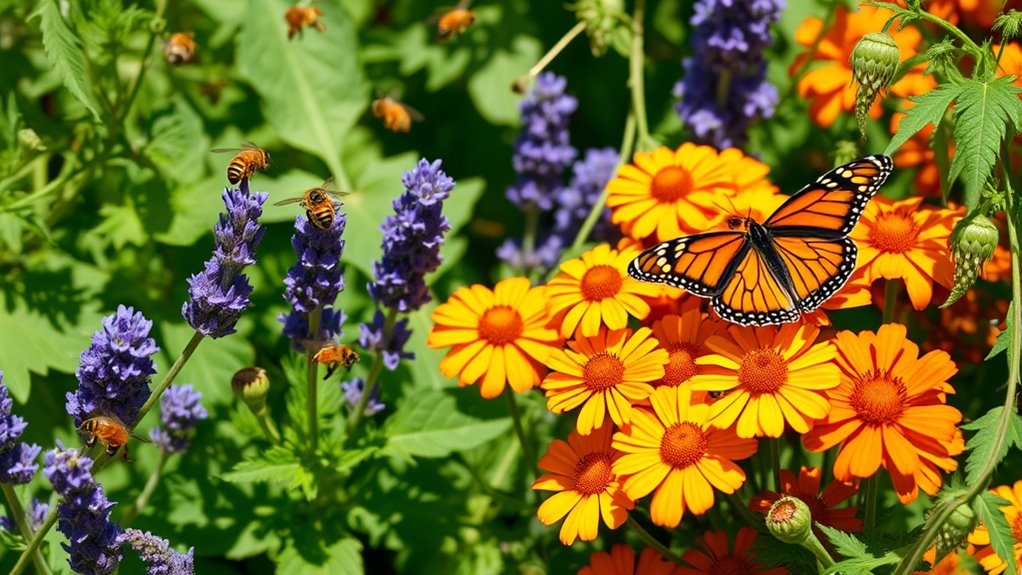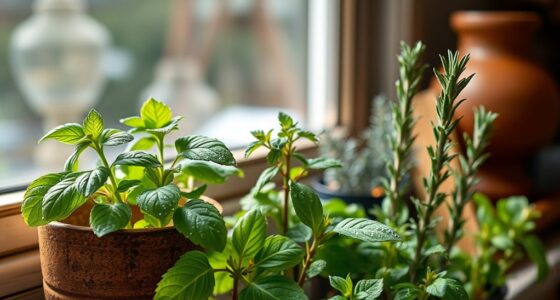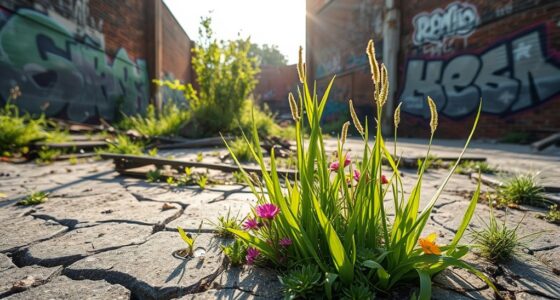To create a pollinator-friendly urban garden that attracts bees and butterflies, use native plants that bloom at different times to provide food year-round. Incorporate flowering shrubs, perennials, and ground covers, avoiding pesticides and using organic methods. Design your space with shelter, nesting sites, and open, nectar-rich flowers. Supporting diverse plants and structures helps sustain healthy pollinator populations. Keep exploring to discover how your garden can become a vibrant refuge for these essential insects.
Key Takeaways
- Incorporate native plants that bloom year-round to provide continuous nectar and pollen for bees and butterflies.
- Avoid pesticides and herbicides, opting for organic gardening practices to protect pollinator health.
- Include a variety of flowering shrubs, perennials, and ground covers to attract diverse pollinator species.
- Design the garden with open, flat-topped flowers and brightly colored blooms to facilitate pollinator feeding.
- Create shelter, nesting sites, and undisturbed areas to support pollinator nesting and overwintering needs.

Urban gardening offers a unique opportunity to support pollinators right in your neighborhood. By choosing the right plants, you can create a vibrant, pollinator-friendly oasis that benefits bees and butterflies alike. One of the most effective strategies is incorporating native plantings into your garden. Native plants are specially adapted to local conditions, making them easier to grow and maintain while providing the essential nectar and pollen that pollinators depend on. These plants attract a variety of bees and butterflies, offering them a reliable food source throughout the year.
Native plants create a sustainable, pollinator-friendly urban garden year-round.
To maximize your garden’s appeal to pollinators, focus on planting seasonal blooms. Different species of bees and butterflies are active at different times of the year, so providing a continuous supply of flowering plants ensures they always have access to nourishment. For example, early spring bulbs and flowering trees can attract pollinators emerging after winter, while summer and fall-blooming flowers sustain them during peak activity periods. By selecting a diverse array of native plants that bloom at various times, you create a dynamic habitat that supports pollinators through all seasons.
When planning your garden, think about the structure of your plantings. Incorporate a mix of flowering shrubs, perennials, and ground covers to offer various landing sites and shelter options. Bees, especially, prefer plants with open, flat-topped flowers, which make collecting nectar and pollen easier. Butterflies, on the other hand, are drawn to brightly colored, nectar-rich flowers. By designing your garden with these preferences in mind, you’ll attract a healthy diversity of pollinators, boosting their populations and helping sustain local ecosystems.
In addition to plant choices, avoid using pesticides and herbicides that can harm these beneficial insects. Instead, opt for organic gardening practices that protect pollinator health. Creating small, undisturbed areas with native grasses or wildflower patches can also provide safe nesting sites and overwintering habitats. Remember, supporting pollinators is a year-round effort; even in small urban spaces, your garden can become a crucial refuge for bees and butterflies.
Frequently Asked Questions
How Can Urban Gardening Support Native Pollinator Species?
Urban gardening supports native pollinator species by creating habitats that attract and sustain them. You can do this by selecting native plants, which provide familiar food sources, and ensuring habitat connectivity, so pollinators can move easily between gardens. This not only boosts local biodiversity but also helps pollinators thrive amidst urban environments. Your efforts in planting and connecting green spaces make a significant difference for native pollinators’ survival.
What Are the Best Plants to Attract Both Bees and Butterflies?
Imagine vibrant native plant varieties, with blooms timing that stretches from early spring to late fall. To attract both bees and butterflies, plant nectar-rich flowers like milkweed, coneflowers, and goldenrod. Provide diverse layers of blooms, ensuring continuous food sources. You support pollinators by choosing plants suited to your climate, offering resources throughout the year, and creating a welcoming habitat that encourages their visit and sustains their populations.
How Do Urban Environments Impact Pollinator Health?
You might notice that urban environments impact pollinator health through air pollution and habitat fragmentation. Air pollution weakens bees and butterflies’ immune systems, making them more vulnerable to diseases. Habitat fragmentation limits their foraging options and nesting sites, reducing their populations. To support pollinators, you can plant native flowers, reduce pesticide use, and create continuous green spaces, helping them thrive despite urban challenges.
Are There Seasonal Considerations for Pollinator Gardening?
You should consider seasonal bloom and year-round planting to support pollinators effectively. In spring and summer, plant nectar-rich flowers to provide abundant food, while in fall, choose plants that offer late-season blooms. During winter, incorporate evergreen plants or create sheltered habitats. This approach guarantees pollinators have access to food throughout the year, maintaining their health and supporting their populations in urban environments.
What Safety Precautions Should Be Taken for Urban Pollinator Gardens?
When creating urban pollinator gardens, you should prioritize safety by avoiding pesticides, which can harm bees and butterflies. Use safe planting practices, such as selecting native plants and avoiding chemical treatments. Keep an eye on your garden to prevent pests naturally and guarantee the environment remains safe for pollinators. Regularly monitor and maintain your garden to support healthy, thriving pollinator populations while minimizing risks to both insects and people.
Conclusion
By creating pollinator-friendly gardens, you play a crucial role in supporting bees and butterflies, essential for healthy ecosystems. Did you know that urban gardens can host up to 70% of native pollinator species? So, your efforts not only beautify your space but also boost pollination and biodiversity. Start planting native flowers today, and watch your garden thrive while helping these vital creatures flourish in city environments.









